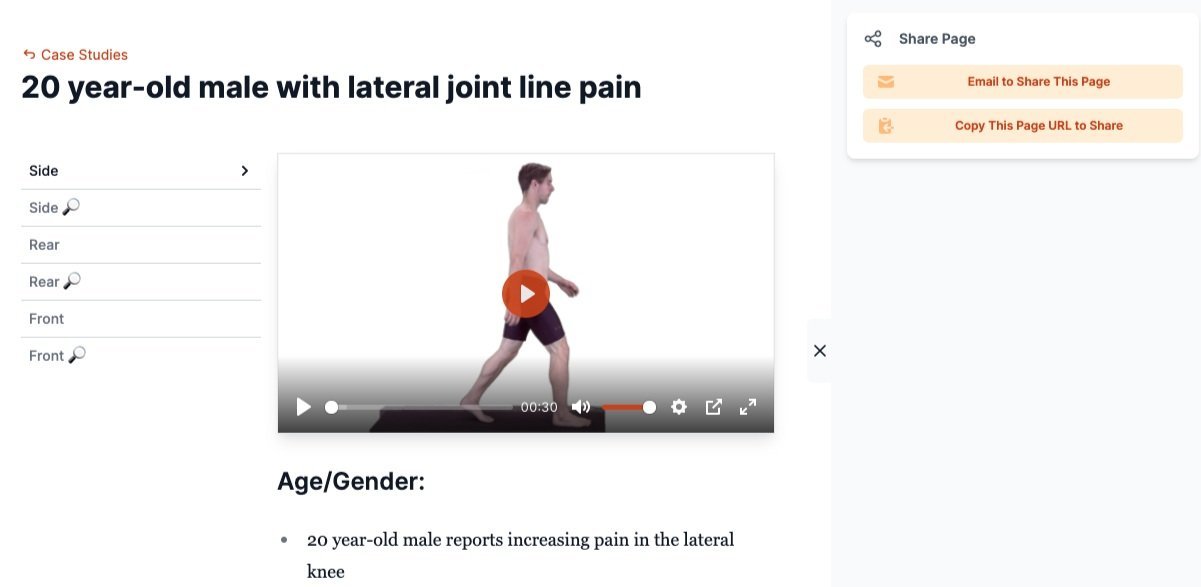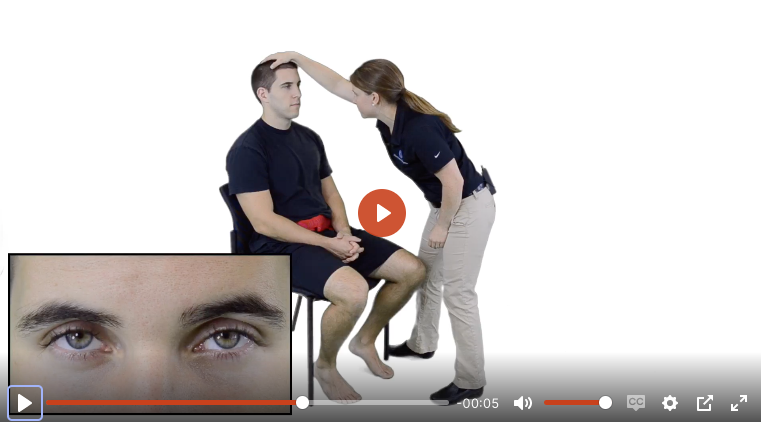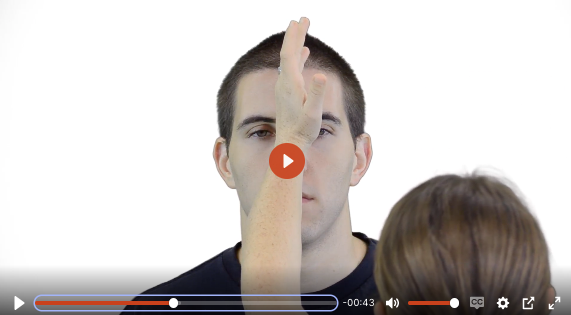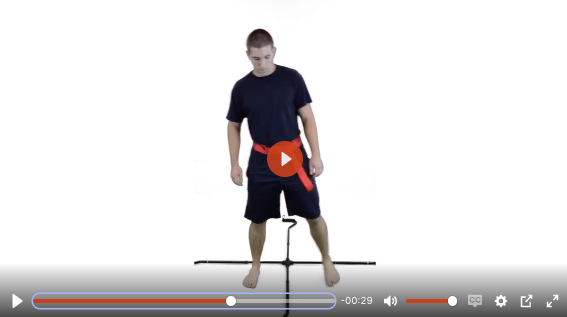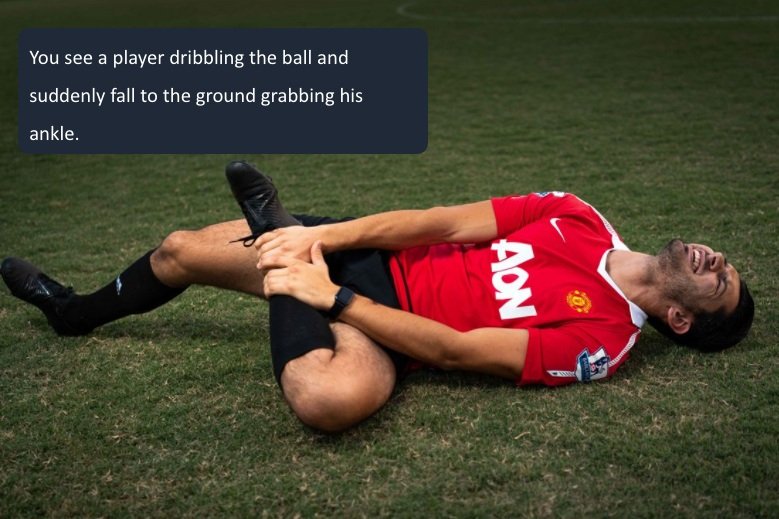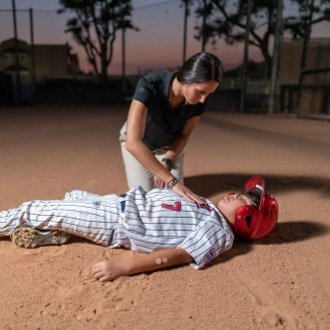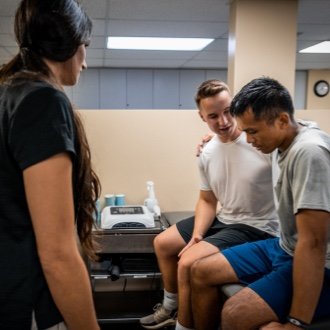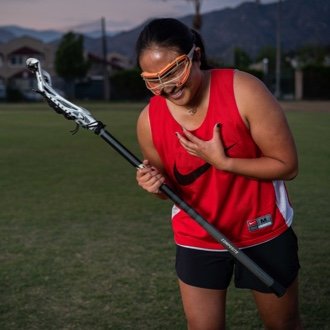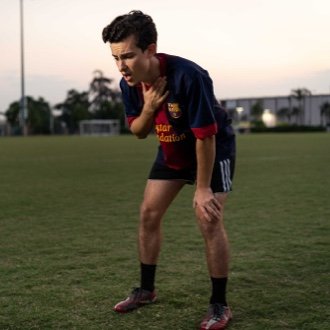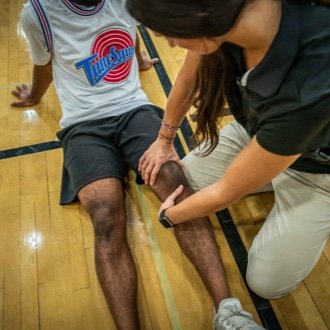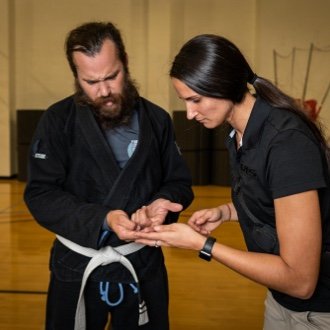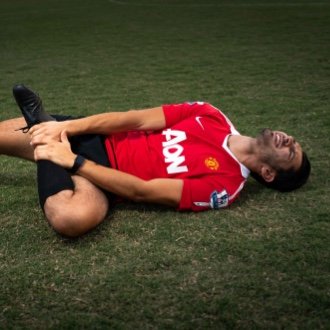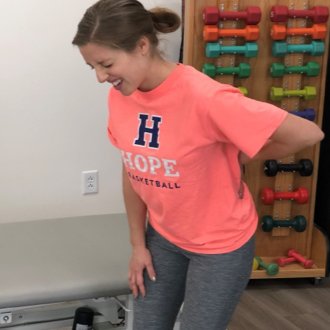The ATu team is excited to welcome Dr. Schmidt to join the team as our Education Lead. He brings 28 years of higher education experience as an educator, clinician, consultant, accreditation peer reviewer, and program administrator to the ATu team. His curriculum development, teaching, and professional service expertise will lead content development. He will be leading the summer series of webinars to help you take your course and your program to another level.
A few words from our Education Lead, Dr. Chris Schmidt, about the upcoming summer product release: this covers NeuroAnatomy, a series of simulations and micro-learning modules that include emergency care updates, posture cases, and much more!
SUMMER WEBINAR SERIES: EVERY FRIDAY AT 12PM PST
ATu has become even more social!
While you are logged in and scrolling away at different techniques, conditions, or exercises, you will see that there is an arrow on the right side of your screen that allows the side bar to appear.
Once the sidebar appears, you will be able to see the tab Share Page with 2 options. If you would like to quickly send the link via text message or email, it is best to select Copy This Page URL to Share.
Simply, click Copy This Page URL to Share to a new text message or email so that others can also enjoy what PhysioU has to offer.
Did you notice this little icon added on to your webapp recently? You can locate it on the upper right corner of your webapp.
START HERE: ADD BOOKMARK
Now once you have discovered a technique, an exercise, a condition, or a case study you would like to bookmark, click the bottom right arrow to allow the sidebar to appear. Then click Add Bookmark.
Add the bookmark to your Main list or a specific custom group you plan to create or have created. Below we have created a group, “Shoulder Pain with Mobility Deficits” to provide an example for you to see.
HOW TO FIND MY SAVED BOOKMARKS & GROUPS
CREATE CUSTOM GROUP
If you are wondering how we made a custom group name, look below! Very easy to do so that 5000+ videos can be seamlessly found! The section headings take your organization skills one step further!
1) Click “Create” to start a group
2) Enter a name to group your bookmarks in one place
3) Add a section heading to organize your bookmarks into different groups
4) Now your bookmarks are organized! It’s that simple!
Curious about what exercises are the BEST exercises for your patients?
When using Exercise Patterns, we guarantee an evidence-based exercise approach that allows you to save time when building patient programs, address specific concerns with specific exercises, and create programs for exclusive patient needs.
Once in the Exercise Patterns web app, you will notice we have all exercises categorized by:
Body Region
Once in a specific body region, you will be able to navigate further to address unique patient needs:
Musculoskeletal Patterns
Post-Operative Programs
Performance
Easy, Effective, and Efficient
Did you know you can also email your program directly to your patients through our app?
As we work our way closer to the beginning of the Spring 2022 semester, it's time to consider your spring coursework, and now is the perfect time to think about the tools and resources that best complement your teaching. When considering the delivery of your coursework, one of the biggest challenges is how to ensure appropriate scaffolding and reinforce the skills we use on a in providing patient care. Students frequently struggle to obtain high-quality resources to reinforce the learning you're teaching, and many find that frustrating and time-consuming.
One of the things that students tend to struggle with is the implementation of neurologically based testing, specifically in the context of evaluation of concussion. Concussion evaluation and treatment has rapidly evolved in the past several years, and so a platform that's able to be nimble and stay up to date on the ever-evolving evidence is critical.
The ATu portal is a crucial resource for your students to reinforce their neurological screenings, as it includes:
And more!
The particular challenge with these skills is that they are SO specific in the technical details for accurate and reliable performance, and the ATu portal allows for students to practice with high-quality reference materials. While these skills may not be used daily, when they are deployed, there's no room for error in dealing with these challenging diagnoses. As such, high-quality and effective repetitions are VITAL.
With the transition to the entry-level Master’s degree for athletic training, educators have been forced to condense the knowledge and skills of a 3+ year educational experience into two short years. Additionally, with the inclusion of immersive clinical experiences, classroom and laboratory learning time has been further concentrated. While the benefits of immersed clinical experience are known and valuable, it forces educators to make optimal use of the limited in-person experiences, and ATu is here to make our lives better.
One of the biggest challenges for graduate educators is balancing the integration of past knowledge (sometimes delivered by another institution or educator with unknown quality) with new content and layered situated learning to maximize retention. Accomplishing all this is a difficult feat regardless of time constraints, however, is exacerbated through the expedited nature of the timeline of graduate work. It requires graduate educators to be innovative and leverage technology solutions to facilitate out-of-classroom learning, which maximizes the value of in-class time.
Envision the following:
1. Prior to class
Prior to class, students are provided a link to the ATu portal to review specific range of motion, palpation, and common orthopedic tests for the body region they will learn about.
2. Night before
Students complete a brief, 10 question quiz due the night before class with low stakes (either ungraded or worth minimal points) as a “keycard to the classroom”.
3. Start class
Educators quickly review the common errors in their quizzes, and start class with a targeted review of those common sticking points
4. During class
Educators then spend classtime with a targeted psychomotor demonstration and practice time, and supplement with real-life scenarios and clinical integration
5. Simulation Learning
Students complete a simulated experience at the end of the body region, to integrate all their knowledge on a simulated virtual patient. This encounter is graded automatically, can be completed multiple times, and students submit their certificate of completion with an affiliated grade to your LMS.
Think about how engaging that experience is! Classroom time is optimized for focused practice, clinical integration, and pearls of knowledge from experienced AT educators. This is VALUE added to the educational experience, and can truly transform the student experience.
After a long hard year, the ATU team salutes all faculty for going above and beyond to keep learning going! As a special gift from ATU, we spent all year dreaming about clinical reasoning development using simulations. Throughout 2021, the team worked closely with faculty to develop clinical scenarios that will enhance clinical reasoning development in a low risk, asynchronous and formative way!
Each evidence-based simulation contains “Educator specific information” and a “Simulation Key.” These simulations are designed around addressing CAATE standards: 70,72,78
Emergency Care Simulations
On-Field Care Simulations
A special shout out to the amazing faculty who contributed to this work:
Matt Mills- ATU program expert, Assistant Professor of Athletic Training, Springfield College
Paul Geisler- Simmons University (Former Director Ithaca College Athletic Training Program)
Jaclyn Schwieterman- Director and Chair, Athletic Training and Sports Medicine Program, Marietta College
David Marchetti- Athletic Trainer and Clinical Professor, King’s College
William Adams- Assistant Professor, Department of Kinesiology, University of North Carolina
Timothy Kulpa- Clinical education director and Clinical Professor, King’s College
Nicholas Tavoukjian, Certified Athletic Trainer, Ph.D. candidate, Azusa Pacific University
Wishing you a great new year of teaching and learning!
Your Partner in Education,
The ATU Team
Here’s how you can download your “ATu Interactive Learning Report “ and email it to your instructor.
After you have completed the module, the download button will be available on the module page.
Click to “Download Learning Report (PDF)”
Email the PDF file to your professor OR upload the PDF file to your learning platform
Download Learning Report feature is available on each Simulation module.
PDF version of ATu Interactive Learning Report.
Challenge your clinical knowledge virtually with ATu!
ATu is delighted to announce new simulation & microlearning modules that have just been added to the web app.
Prepare for tests and quizzes
Self-knowledge checks
Develop clinical reasoning
Board exam test preparation
Transcutaneous Electrical Nerve Stimulation for Low Back A
Transcutaneous Electrical Nerve Stimulation for Upper Extremity
Interferential Current for Upper Extremity
Interferential Current for Low Back
Shoulder External rotation
Knee Extension
Elbow Flexion
Ankle Dorsiflexion
Toe Extension
Hip Abduction
As we continue to move through the "new normal" of higher education and AT education, it is increasingly clear that technology can assist with the development of highly functioning athletic trainers. Through the use of simulation, students can gain repetition and develop pattern recognition to allow for more effective clinical care with their respective patient populations. This has increasingly been evident through the challenge of developing and maintaining high-quality clinical affiliations and helps mitigate some of the uncertainty regarding the availability of clinical sites. This exciting development is consistent with the CAATE standards, which allow for simulation to supplement clinical experience to demonstrate compliance with the standards.
As such, the ATu faculty team is excited to announce the launch of ATu simulations - ROM/MMT and Physical Agents (Sign up for your complimentary faculty access here to explore the ATu web app today), which can allow your students to engage in clinical decision-making in a low-stakes environment to augment clinical experiences. By allowing students to gain exposure to an increasing variety of health conditions to supplement in-class experiences and clinical exposures, students can gain the confidence needed to make appropriate and reasonable clinical decisions.
Click any below image for a better viewing
Additionally, the use of "Mini-Games" to reinforce key learning points or skills can allow for students to get the virtual "reps" that are needed to engrain quality procedures and protocols through the skill development process. These simulations can allow for students to quickly verify their understanding of key clinical concepts, and allow them to more easily integrate into their clinical experiences upon arrival.
We're thrilled to provide these additional resources to enhance student learning and look forward to your feedback. Please don't hesitate to reach out if you have any questions, comments, concerns, or just want to set up a 1 on 1 talk to discuss how to integrate these into your current pedagogy.
For the past year, the ATu team has been beefing up the web app suite. Our goal is to make learning easy by providing a web-based centralized solution to the Athletic Training Education community.
Here’s how our apps support the CAATE standards:
| CAATE Standards / Section IV: Curricular Content | ATu package |
|---|---|
| Prerequisite Coursework and Foundational Knowledge | |
| 54: Professional program | ✔ |
| 55: Foundational Knowledge | ✔ |
Care Plan |
| 69: Develop a care plan for each patient. | ✔ |
Examination, Diagnosis, and Intervention |
| 70: Evaluate and manage patients with acute conditions | ✔ |
| 71: Perform an examination to formulate a diagnosis | ✔ |
| 73: Select and incorporate interventions | ✔ |
| 74: Educate patients regarding appropriate pharmacological agents | ✔ |
| 75: Administer medications or other therapeutic agents | ✔ |
| 76: Evaluate and treat a patient with brain injury | ✔ |
| 78: Select, fabricate, and/or customize assistive devices | ✔ |
| Prevention, Health Promotion, and Wellness | |
| 79: Develop/implement strategies for long-term health conditions | ✔ |
| 86: Select/fit/remove protective equipment to reduce the risk of injury/re-injury | ✔ |
CAATE Standard: 78
78: Select, fabricate, and/or customize prophylactic, assistive, and restrictive devices, materials, and techniques for incorporation into the plan of care.
ATU: Cardiopulmonary Rehabilitation
Overview of common cardiac conditions
Assessment of Vital Signs including lung sounds and cardiac auscultation
CAATE Standards: 71/79
71: Perform an examination to formulate a diagnosis and plan of care for patients with health conditions commonly seen in athletic training practice. T
79: Develop and implement strategies to mitigate the risk for long-term health conditions across the lifespan.
ATU:Emergency Care
Overviews of emergent conditions including:
Cardiac Compromise
Respiratory Compromise
Environmental Conditions
Cervical Spine Injury
Fractures and Dislocations
Anaphylaxis
Drug Overdose
Diabetes
Emergent interventions for the above conditions
CAATE Standard: 70
70: Evaluate and manage patients with acute conditions, including triaging conditions that are life threatening or otherwise emergent
ATU:Exercise Patterns
Videos of mobility, stretching, and strengthening exercises for full body based on pain, mobility limitations, and sensory deficits
Post-operative guidelines for common surgeries
Performance training for injury prevention
CAATE Standard: 73
73: Select and incorporate interventions (for pre-op patients, post-op patients, and patients with nonsurgical conditions) that align with the care plan.
ATU:Gait
Video breakdown of gait pattern with application of ROM and muscle activity
CAATE Standard: 71
71: Perform an examination to formulate a diagnosis and plan of care for patients with health conditions commonly seen in athletic training practice
ATU:NeuroExam
Videos of
Motor Control Videos of Assessments
Sensation Videos testing of all types
Muscle Tone assessment for UE and LE
Typical and pathological performance of deep tendon reflexes
Coordination testing
Variety of Balance and Gait Assessments
Assessment of Vestibular Dysfunction
Cranial Nerve Exam
CAATE Standard: 71/76
71: Perform an examination to formulate a diagnosis and plan of care for patients with health conditions commonly seen in athletic training practice
76: Evaluate and treat a patient who has sustained a concussion or other brain injury, with consideration of established guidelines.
ATU:Orthopaedics
Breakdown of presentations of various pain patterns and injuries with ideas for physical exam, special tests, manual therapy, and exercises
Combines orthopedic evaluation and interventions
CAATE Standard: 69/71/73
69: Develop a care plan for each patient.
71: Perform an examination to formulate a diagnosis and plan of care for patients with health conditions commonly seen in athletic training practice
73: Select and incorporate interventions (for pre-op patients, post-op patients, and patients with nonsurgical conditions) that align with the care plan.
ATU:PNF
Video breakdown of principles and philosophy of PNF.
Videos of techniques, patterns, and progression of skills development for advancing functional abilities
CAATE Standard: 73
73: Select and incorporate interventions (for pre-op patients, post-op patients, and patients with nonsurgical conditions) that align with the care plan.
ATU:Patient Education
Information and videos for patients to utilize for home programing and to better understand their condition
CAATE Standard: 69/71/73
69: Develop a care plan for each patient.
71: Perform an examination to formulate a diagnosis and plan of care for patients with health conditions commonly seen in athletic training practice
73: Select and incorporate interventions (for pre-op patients, post-op patients, and patients with nonsurgical conditions) that align with the care plan.
ATU: Pharmacology
Information on a variety of medications and clinical implications of utilization of these medications
CAATE Standard: 74/75
74: Educate patients regarding appropriate pharmacological agents for the management of their condition, including indications, contraindications, dosing, interactions, and adverse reactions.
75: Administer medications or other therapeutic agents by the appropriate route of administration upon the order of a physician or other provider with legal prescribing authority.
ATU: Physical Agents
Information about all types of physical modalities including Purpose, use, contraindications or precautions, set, and patient education
CAATE Standard: 73
73: Select and incorporate interventions (for pre-op patients, post-op patients, and patients with nonsurgical conditions) that align with the care plan.
ATU: Physical Agents Simulations (Fall release)
Short patient-based scenarios are designed to help students apply and interpret learned knowledge in a simulated clinical environment.
CAATE Standard: 73
73: Select and incorporate interventions (for pre-op patients, post-op patients, and patients with nonsurgical conditions) that align with the care plan.
ATU: ROM, MMT, and Palpation
Videos of
Palpation for bony landmarks and soft tissues
ROM and MMT for all joints and movements
Neuro-screens for all dermatomes, myotomes, and reflexes
CAATE Standard: 71
71: Perform an examination to formulate a diagnosis and plan of care for patients with health conditions commonly seen in athletic training practice.
ATU: ROM, MMT, and Palpation (Fall release)
Short patient-based scenarios are designed to help students apply and interpret learned knowledge in a simulated clinical environment.
CAATE Standard: 71
71: Perform an examination to formulate a diagnosis and plan of care for patients with health conditions commonly seen in athletic training practice.
ATU: Special Tests
Videos of special tests for full body
Background information and evidence base of on all special tests
CAATE Standard: 71
71: Perform an examination to formulate a diagnosis and plan of care for patients with health conditions commonly seen in athletic training practice.
ATU: Evidence-Based Taping
Videos demonstrating the theory, application, and evidence behind common taping interventions
CAATE Standard: 78/86
78: Select, fabricate, and/or customize prophylactic, assistive, and restrictive devices, materials, and techniques for incorporation into the plan of care.
86: Select, fit, and remove protective equipment to minimize the risk of injury or re-injury
ATU: Surface Anatomy Palpation (Fall release)
In-depth demonstration of palpation of common and relevant anatomic structures
CAATE Standard: 54/55
54: The professional program requires prerequisite classes in biology, chemistry, physics, psychology, anatomy, and physiology at the postsecondary level.
55: Students must gain foundational knowledge in statistics, research design, epidemiology, pathophysiology, biomechanics and pathomechanics, exercise physiology, nutrition, human anatomy, pharmacology, public health, and health care delivery and payor systems.
The fall is just a month a way and the ATu team has been working tirelessly to create new apps to enhance teaching and learning! After careful assessment of the various curricular needs, ATu is releasing new products this Fall.
Evidence-based Taping
The first evidence-based taping app that covers the most common taping techniques including basic principles of taping and materials
Surface Anatomy Palpation
A groundbreaking app mixing the art and science of a master clinician (all muscles, bones, and nerve entrapment are hand-drawn onto the subject)
//Return to our normal Discounted Student Pricing//
In 2020, we gave ATu to all faculty and students for free to support education during the challenging year.
We are back to our normal discounted pricing for students to continue to support filming of patients, new app development, and simulation development; only $99.00 per year, (Full value $199/year), which is $8.25/month. There are enhanced savings for multiple-year subscriptions and additional discounts for bulk orders by academic programs.
For schools: Please follow this link to submit your request and place the order early. We want to make sure your students will have ATu on the first day of class.
For students: Buy direct on our website and enjoy over 50% off student rates.
For the teaching community: On top of these releases, our faculty team is hosting regular webinars throughout the year. We will discuss ways to enhance hybrid learning with ATu and dive into specific specialty areas. If you can't make it to the live webinars, that's ok. You can view these recorded webinars at your leisure here.
This webinar will showcase the latest ATu breakthrough in Athletic Training Education, the Emergency Care Application. Join Matt Mills, MA, LAT, ATC, PES for a deep-dive walkthrough and suggestions for implementation in your Emergency Care class and laboratory experiences!
0:02 Introduction
1:38 Checking In!
2:38 Designed Around 2020 CAATE Standard 70
3:38 Special Thanks to Dr. Lynette Carlson
4:15 Going through the Emergency Care App
5:33 Trauma Based Component
12:03 Wound Care Closure
15:35:00 Dislocations
19:11:00 Acute Cervical Spine Injuries
20:35:00 Equipment Intensive Athletes
24:32:00 Emergency Conditions
37:15:00 E-Care Simulations
49:10:00 3 Simple Ways to use ATU Apps in Classroom
51:47:00 Ideas or Needs
53:30:00 Questions & Answers
Join Matt Mills, MA, LAT, ATC, PES in an interactive discussion about the latest & upcoming apps - PNF, Pharmacology, Taping, Emergency Care for deep learning and how the ATu apps are being used in the classroom.
Join Matt Mills, MA, LAT, ATC, PES in an interactive discussion about ATu apps for deep learning and how the ATu apps are being used in the classroom.
Dear Faculty Fellows,
The Proprioceptive Neuromuscular Facilitation App (PNF) has been added to your ATuWeb App Suite!
Announcement from Dr. Michael Wong
App WalkThrough and Lab Handouts
You can find the PNF lab handouts here. It’s under the “Teaching Content” section.
If you are a faculty member and don't have an ATu login, please submit your request here.
Please feel free to start using it and sending us feedback to care@atu.health. We can make adjustments "Over the air"!
Use the ROM/MMT app and Clinical Prediction apps to enhance your orthopedic evaluation and treatment courses in a remote learning environment.
Watched these "Best" practice for using the ATu applications to foster critical thinking in a distance learning environment hosted by Matt Mills, ATu Program Expert
Exploring fundamental skills apps and how to support the Hyflex hybrid learning model!
0:00:46 About ATU Founder and ATU Content Development Lead
0:06:06 The Hyflex model
12:36;29 Motor skills development online
13:01 Augmenting your labs easily with high definition video for teaching motor skills
15:29 Pre-made Lab handouts for ROM MMT Palpation
22:17 Systematic approach to motor skill development- “Tips from the trenches”
36:02 Testing of motor skills how to run the “online” practical exam
43:44 Using the ATU Gait app to teach gait analysis
49:51 How to use the ATU Physical Agents app to teach modalities
54:32 How to teach Assistive Devices and Gait training with the ATU Assistive devices app
57:16 Sneak Peek at new apps: University of Idaho collaboration: Virtual Reality Gait analysis
58:21 Sneak Peek at new apps: Functional movement app
1:00:12 How to get Free access for your AT students through Dec 31, 2021 atu.health/covid
COVID-19 has significantly changed the Athletic Training education landscape, including moving us to completely online since March 2020. With the fall looking different than ever before, educators need to adapt quickly to ensure a high-quality educational experience for their students in preparation for practice and clinical capability.
ATu's program expert, Matt Mills, MA, LAT, ATC, PES, will be hosting the webinar: Simple ways to integrate ATu technology into your online classroom
Easily augment your lab handouts with video content to enhance motor skill training
Use interactive multimedia to facilitate online discussion and clinical reasoning
Utilizing Clinical Pattern Recognition apps to help students see the "Big Picture" to build context for deeper learning
Please join us for a quick user guide webinar and roundtable discussion as we explore how to serve our students well in this challenging time!
Sign up for your classroom: ATu.health/covid
Sign up for faculty access for you and your colleagues by emailing us at care@atu.health
Helpful Links: Virtual classroom access | Faculty access | Other free resources



